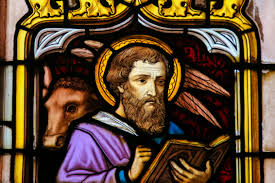 St Alban’s Episcopal Church Bolivar, Missouri Thursday, October 20, 2022 Remembering St Luke  Episcopalians in this diocese have reason to be proud – St Luke’s Health System is a ministry of the Episcopal Church. Two hospitals: St Luke’s North and St Luke’s South, St Luke’s residential hospice and Bishop Spencer Place, a retirement and rehab center are still under the oversight of the Diocese of West Missouri. The bishop serves as chair of the Board of Directors. The predecessor of this now huge system, was founded by an Episcopal priest, The Rev. Henry David Jardine in 1882. (Yes, you know that name – our bishop sf the Rt Rev. Diane Jardine Bruce…) But why is it called, St Luke’s? The Bible calls him a physician, in Colossians. The church has associated him with doctors and healing ever since.  The picture above is the entrance to St Luke’s Hospice – Below is the chapel at the hospice. What about the gospel of Luke? As you have probably noticed, we read the Gospel of Luke during lectionary Year C – That began last Advent and will continue until the end of ordinary time on November 20. (With the beginning of Advent, November 27, 2022 we will begin again in Year A, to read through the Gospel of Matthew.) If you are a careful reader or listener, you will recognize that there is a huge difference in tone and emphasis between Matthew, Mark (Year B) and Luke. Luke is the only gospel to include the familiar infancy narratives – Mary and the angel, shepherds, angels in the field the baby in a manger. And Luke is full of stories of healing. He emphasizes God’s welcome of outsiders, foreigners, Gentiles, women and children.  What’s with the winged ox – bull? Each of the four evangelists has a traditional symbol that often stands in for pictures of the men themselves. Luke’s symbol is the sacrificial animal – because his gospel begins and ends in the Temple, where sacrifices are offered – in Luke’s mind, Jesus himself is the one that is offered, and the one who offers himself. It is a reflection of the sense of self-giving that I repeat at nearly every Eucharist, although it is not a Lucan phrase: “Walk in love, as Christ loved us and gave himself for us, an offering and a sacrifice to God” (Ephesians 5:2) And the wings? Each of the symbol has wings! Matthew’s is alternatively a winged man or an angel, Mark’s is a winged lion, Luke’s a winged ox, and John’s an eagle – The work of an evangelist, is to spread the evangel – the good news – and wings represent speed – the ability to get the news quickly from one place to another. |

Categories:
Tags:
No responses yet